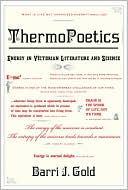

 |

|

The average rating for ThermoPoetics: Energy in Victorian Literature and Science based on 2 reviews is 3.5 stars.
Review # 1 was written on 2018-02-15 00:00:00 Chantal Seremty Chantal SeremtyBarri Gold sets out on an ambitious task with ThermoPoetics. In one sense, she seeks an underlying synthesis between the emergence of thermodynamics in 19th-century Europe and the Victorian novels that shaped a socio-political framework. Put another way, she seeks connections between the works of leading Victorian authors and the emergence of "energy physics" (Gold's synonymization of thermodynamics). In another sense, she grasps at straws by making parallels to authors' ambiguous descriptors regarding an event, person, or situation that seems to allude more to the metaphysical than the physical. Gold outlines the aims of the project rather succinctly in the opening chapter, outlining what is meant by "thermopoetics." The book's first real treatment of this idea is shown through Tennyson's In Memoriam, which draws spiritual connections between love, loss, and the conservation of energy. It may strike the reader as a little heady but is nevertheless poetic. It's a good first taste; however, if the reader has trouble swallowing this bit, then ThermoPoetics will do very little to change mind. The book continues with a slivered history of thermodynamics' emergence by reviewing conceptions of the subject's founders, including Kelvin and Clausius, and the oh-so infamous second law of thermodynamics, which the author, like many others, erroneously likens to disorder. This is not necessarily the fault of the writer but rather is a result of the can of worms opened by discussing the history of thermodynamics, which is rife with terminological and conceptual confusion. For example, Gold mentions entropy characteristically increases and first introduces the classical equation for entropy derived by Clausius. However, later in the book, she describes entropy using Boltzmann's formalism (p. 251, "count up all the possible arrangements of… molecules"), which is not the same as Clausius' classical conceptualization that pertains to heat engines. This shift in definition will leave the unsuspecting reader scratching their head. It is this sort of muddiness that is inherent in the history of thermodynamics (specifically, the shift from classical to Boltzmann-statistical) that Gold would do well to explain in some degree or other. Not doing so creates a disadvantage to those unfamiliar with the field of thermodynamics, resulting in not a connection between literature and science but rather an extreme lack of clarity. This leads one to wonder who the target audience for this book is: those with a background in physics or in Victorian literature? According to the introduction, it's probably the latter, but such individuals will be prone to confusion especially, negatively impacting the attempt to connect the science to the literature, and vice versa. Delving deep into the literature while only skimming over particular surfaces of the science feels awfully deceiving and inadequate. Gold does a fine job explicating the idea of closed systems and energy transfers with a heat bath, but the book takes a turn for the worst when it returns to the "conversation" between Victorian literature and energy physics in the latter half of the book. Upon reading the chapters concerning Dickens' Bleak House, Wilde's Dorian Gray, and Stoker's Dracula, one may reflect in thinking that Gold has simply lost her marbles with the type of loose, hand-wavy, metaphysical connections drawn between a simple statement and a universal law of physics. In essence, if the reader makes it beyond Bulwer-Lytton's chapter, which is quite good, then there surely will be considerable disappointment or stupefaction with what follows. An example of inanity can be found in Chapter 6, p. 241, where blood is likened to energy, with the former being a fluid-flow analogy to the latter. Thinking of energy as a fluid is not adequate in understand the very nature of energy and how it functions in chemical or physical processes. For conceptual clarity, charges through a circuit are often characterized as a fluid through a pipe, but energy is not likened this way. On the whole, Gold does a fine job conveying basic thermodynamic concepts, like the entropic irreversibility, kinetic theory of gases, and condensers. Perhaps the most appreciative moments are found when she plucks out the good bits of The Time Machine, or how she dives into Spencerian evolutionary theory. There is good content here, the writing is at times witty, and the whole work oozes charm and is uniquely constructed. That said, ThermoPoetics' lack of clarity, unknown target audience, and philosophy-defying reaches may result in readers walking away not really grasping either side of the conversation the book wishes to establish. |
Review # 2 was written on 2017-07-16 00:00:00 LEE LITTLETON LEE LITTLETONThis was not the first biography I read of these four individuals. This book made these men real people, with a focus on their human side. This human dimension underlines the fact that God use ordinary people to do extraordinary things - if they are willing and in a living relationship with God. Be blessed when reading this inspirational book. |
CAN'T FIND WHAT YOU'RE LOOKING FOR? CLICK HERE!!!